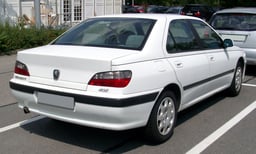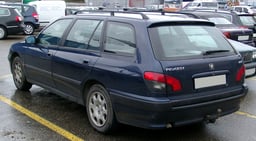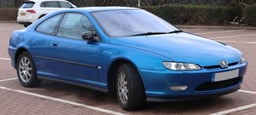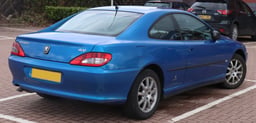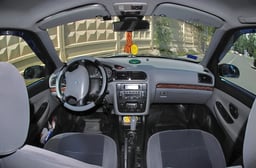Peugeot 406
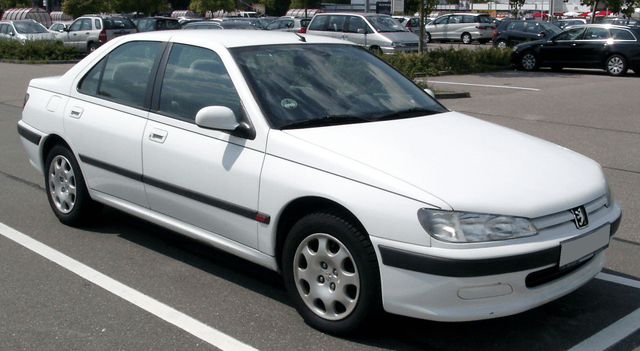
Peugeot 406

| Peugeot 406 | |
|---|---|
| Overview | |
| Manufacturer | Peugeot |
| Also called | Peugeot Coupé |
| Production | 1995–2004 (France, United Kingdom)1996–2008 (Egypt)1997–2003 (Italy, coupé) |
| Assembly | Sochaux,France(Sochaux Plant)Ryton,United Kingdom(Ryton Plant)Val di Sangro,ItalyCairo,Egypt(AAV)Iran٫Tehran(IKCO) |
| Designer | Laurent Rossi (sedan) (1991)Davide Arcangeli andLorenzo RamaciottiatPininfarina(coupé)[1] |
| Body and chassis | |
| Class | Large family car(D) |
| Body style | 4-doorsaloon5-doorestate2-doorcoupé |
| Layout | Front-engine, front-wheel-drive |
| Related | Citroën Xantia |
| Powertrain | |
| Engine | 1.6LI4(petrol)1.8 LI4(petrol)2.0 LI4(petrol)2.0 LI4turbo(petrol)2.2 LI4(petrol)2.9 LV6(petrol)1.9 LI4(diesel)2.0 LI4(diesel)2.1 LI4(diesel)2.2 LI4(diesel) |
| Transmission | 4-speed automatic5-speed manual |
| Dimensions | |
| Wheelbase | 2,700 mm (106.3 in) |
| Length | 4,555 mm (179.3 in) (sedan)4,736 mm (186.5 in) (wagon)4,615 mm (181.7 in) (coupé) |
| Width | 1,764 mm (69.4 in) (sedan)1,760 mm (69.3 in) (wagon)1,781 mm (70.1 in) (coupé) |
| Height | 1,396 mm (55.0 in) |
| Chronology | |
| Predecessor | Peugeot 405 |
| Successor | Peugeot 407 |
The Peugeot 406 is a large family car that was produced by French automaker Peugeot between 1995 and 2004. Available in saloon, estate and coupé bodystyles with a choice of petrol or turbodiesel engines, the 406 replaced the Peugeot 405 in Peugeot's lineup, and was itself replaced by the Peugeot 407. It used the same platform as the Citroën Xantia, though without that car's sophisticated hydropneumatic suspension system.
| Peugeot 406 | |
|---|---|
| Overview | |
| Manufacturer | Peugeot |
| Also called | Peugeot Coupé |
| Production | 1995–2004 (France, United Kingdom)1996–2008 (Egypt)1997–2003 (Italy, coupé) |
| Assembly | Sochaux,France(Sochaux Plant)Ryton,United Kingdom(Ryton Plant)Val di Sangro,ItalyCairo,Egypt(AAV)Iran٫Tehran(IKCO) |
| Designer | Laurent Rossi (sedan) (1991)Davide Arcangeli andLorenzo RamaciottiatPininfarina(coupé)[1] |
| Body and chassis | |
| Class | Large family car(D) |
| Body style | 4-doorsaloon5-doorestate2-doorcoupé |
| Layout | Front-engine, front-wheel-drive |
| Related | Citroën Xantia |
| Powertrain | |
| Engine | 1.6LI4(petrol)1.8 LI4(petrol)2.0 LI4(petrol)2.0 LI4turbo(petrol)2.2 LI4(petrol)2.9 LV6(petrol)1.9 LI4(diesel)2.0 LI4(diesel)2.1 LI4(diesel)2.2 LI4(diesel) |
| Transmission | 4-speed automatic5-speed manual |
| Dimensions | |
| Wheelbase | 2,700 mm (106.3 in) |
| Length | 4,555 mm (179.3 in) (sedan)4,736 mm (186.5 in) (wagon)4,615 mm (181.7 in) (coupé) |
| Width | 1,764 mm (69.4 in) (sedan)1,760 mm (69.3 in) (wagon)1,781 mm (70.1 in) (coupé) |
| Height | 1,396 mm (55.0 in) |
| Chronology | |
| Predecessor | Peugeot 405 |
| Successor | Peugeot 407 |
The project
The styling of the 406 is heavily influenced by its predecessor, the 405, which began to be phased out from the 406's launch in September 1995, and eventually finished production in Europe in 1997, when the last estate models were discontinued.
United Kingdom sales of the 406 began in February 1996.PEUGEOT's 406 range will arrive with a spectacular car launch campaign in Britain next year. | Motor Trader [10]
Initially, the car was available with 1.8 L and 2.0 L petrol and 1.9 L turbodiesel engines, followed by a turbocharged 2.0 petrol, 2.9 (2946 cc, badged as a 3.0) V6 petrol, and 110 bhp 2.1 L turbodiesel. The diesel versions were very popular, and the 406 became one of Europe's best selling diesel powered cars.
The two door coupé, launched at the 1996 Paris Motor Show, was both designed and manufactured by Italian design studio Pininfarina, with choices of a 2.0 L four cylinder engine or a 3.0 L V6, and from 2001, a 2.2 L HDi diesel engine. On later models, a 2.2 L petrol engine was available. A total of 107,633 coupés were made.
The design was originally offered to Fiat by Pininfarina in about 1990, only for Fiat to reject the design and design its own coupe.[2]
For its final year on sale in the United Kingdom, the model was simply called the Peugeot Coupé, with the 406 branding dropped from the name. The 406 was notably successful in the United Kingdom, having broken into the country's key fleet sales market,[3] with a high percentage of units becoming company cars and taxis.
In August 2002, a Peugeot 406 HDi set the world record for the longest distance driven on a single tank of fuel.
The car travelled across Australia between Melbourne to Rockhampton, with a total distance of 2,348 km. [1] [11] Peugeot - Fuel Economy World Records [12] Knock-down kit versions of the car were also built at the Yontrakit Industrial Factory in Lad Krabang, Bangkok, Thailand.
Engines
| Model | Engine-type | Cylinders /valves | Displacement | Power / rpm | Torque / rpm | Years |
|---|---|---|---|---|---|---|
| Petrol | ||||||
| 1.6 | XU5 JP (BFZ) | 4 / 8 | 1580 cc | 88 PS (65 kW; 87 hp) / 6000 | 130 N⋅m (96 lb⋅ft) / 2600 | 1996–1997 |
| 1.8 | XU7 JB | 4 / 8 | 1761 cc | 90 PS (66 kW; 89 hp) / 5000 | 147 N⋅m (108 lb⋅ft) / 2600 | 1997–1999 |
| 1.8 | XU7 JP4 | 4 / 16 | 1761 cc | 112 PS (82 kW; 110 hp) / 5500 | 155 N⋅m (114 lb⋅ft) / 4250 | 1996–2000 |
| 1.8 | EW7 J4 | 4 / 16 | 1749 cc | 117 PS (86 kW; 115 hp) / 5500 | 160 N⋅m (118 lb⋅ft) / 4000 | 1999–2004 |
| 2.0 | XU10 J4R (RFV) | 4 / 16 | 1998 cc | 132 PS (97 kW; 130 hp) / 5500 | 180 N⋅m (133 lb⋅ft) / 4200 | 1996–2000 |
| 2.0 | EW10 J4 (RFN) | 4 / 16 | 1997 cc | 136 PS (100 kW; 134 hp) / 6000 | 190 N⋅m (140 lb⋅ft) / 4100 | 1999–2003 |
| 2.0 | EW10 J4 (RFR) | 4 / 16 | 1997 cc | 139 PS (102 kW; 137 hp) / 6000 | 197 N⋅m (145 lb⋅ft) / 4100 | 1999–2000 |
| EW10 D (RLZ) | 4 / 16 | 1997 cc | 140 PS (100 kW; 140 hp) / 6000 | 192 N⋅m (142 lb⋅ft) / 4000 | 2001–2004 | |
| Turbo | XU10 J2TE | 4 / 8 | 1998 cc | 147 PS (108 kW; 145 hp) / 5300 | 235 N⋅m (173 lb⋅ft) / 2500 | 1997–1999 |
| 2.2 | EW12 J4 (3FZ) | 4 / 16 | 2231 cc | 158 PS (116 kW; 156 hp) / 5650 | 217 N⋅m (160 lb⋅ft) / 3900 | 1999–2003 |
| ES9 J4 (XFZ) | 6 / 24 | 2946 cc | 190 PS (140 kW; 190 hp) / 5500 | 267 N⋅m (197 lb⋅ft) / 4000 | 1997–2000 | |
| V6 | ES9 J4S (XFX) | 6 / 24 | 2946 cc | 207 PS (152 kW; 204 hp) / 6000 | 280 N⋅m (210 lb⋅ft) / 3750 | 1999–2003 |
| Diesel | ||||||
| XUD9 TE/Y | 4 / 8 | 1905 cc | 90 PS (66 kW; 89 hp) / 4000 | 196 N⋅m (145 lb⋅ft) / 2250 | 1995–1999 | |
| HDi | DW10 TD (RHY) | 4 / 8 | 1997 cc | 90 PS (66 kW; 89 hp) / 4000 | 205 N⋅m (151 lb⋅ft) / 1900 | 1999–2003 |
| DW10 ATED (RHZ) | 4 / 8 | 1997 cc | 109 PS (80 kW; 108 hp) / 4000 | 250 N⋅m (184 lb⋅ft) / 1750 | 1999–2004 | |
| TD | XUD11 BTE | 4 / 12 | 2088 cc | 109 PS (80 kW; 108 hp) / 4300 | 250 N⋅m (184 lb⋅ft) / 2000 | 1995–1999 |
| DW12 TED4 (4HX) | 4 / 16 | 2179 cc | 133 PS (98 kW; 131 hp) / 4000 | 314 N⋅m (232 lb⋅ft) / 2000 | 2001–2003 | |
Facelift
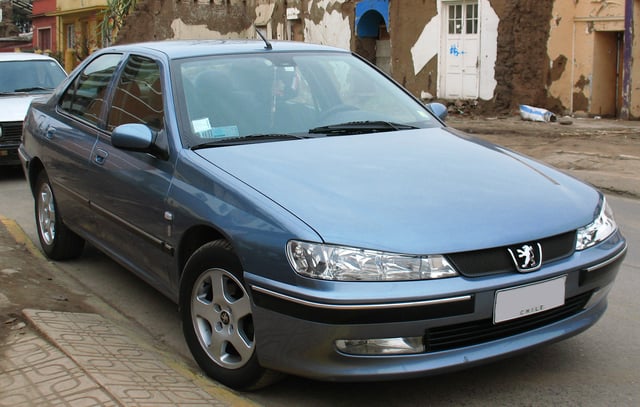
Post facelift Peugeot 406 ST
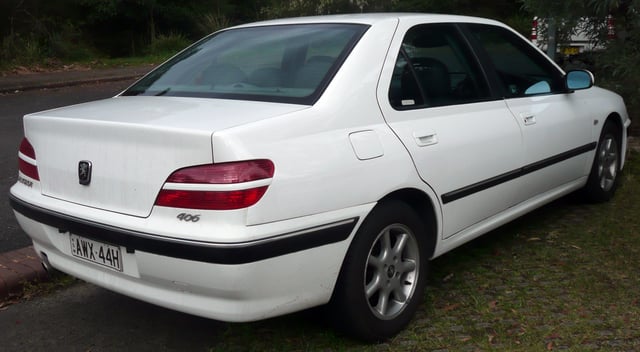
Post facelift Peugeot 406 sedan
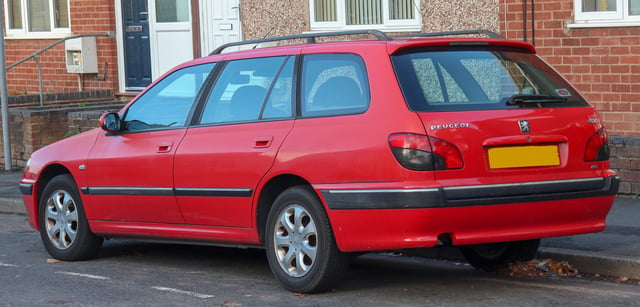
Post facelift Peugeot 406 Estate
| Euro NCAPtest results | ||
|---|---|---|
| Peugeot 406 (1997)[4] | ||
| Test | Score | Rating |
| Adult occupant: | 15 | |
| Pedestrian: | N/A | |
| Euro NCAPtest results | ||
|---|---|---|
| Peugeot 406 (2001)[5] | ||
| Test | Score | Rating |
| Adult occupant: | 18 | |
| Pedestrian: | 14 | |
The facelifted 406 sedan was introduced in February 1999, and safety, strength and speed enhancements resulted in improved Euro NCAP performance. Where the old 406 had one star and a struck off star, the post facelift models gained three stars.[6]
The changes included the new and improved EW/DW Engine Family HDI with greater power, torque and fuel efficiency along with increased refinement, making it comparatively quiet for a diesel. A downside was an increase in the car's insurance group from 9 to 12.[7]
The exterior look was amended as the 406 featured more pronounced ribs, clear headlights, chrome trim and a new honeycomb grill.
The rear lights were finished in red with a strip of the car's paint colour across the centre.
The interior was also redesigned to improve comfort and space.
New equipment included automated digital climate control/air conditioning on most models except the most basic and a multi function display for warning messages, trip computer, radio and external temperature.
There was a more extensive use of wooden trim, better quality plastics, including soft touch plastics, and in addition some models received electrically folding mirrors, with automatic headlights and wipers.
The top of the range Executive model was specified a ten speaker JBL sound system, electrically adjusted and heated leather seats, a memory position for the seats and mirrors, headlight washer jets, a rear sun blind, thicker carpeting, lights in the sun visors, satellite navigation and ambient lighting.
Awards
The 406 was awarded 1997 What Car? Car of the Year, as well as 1997 and 2001 Caravan Club Towcar of the Year. It was also awarded Semperit Irish Car of the Year for 1997, however, it lost out by a narrow margin of 15 points in the 1996 European Car of the Year award to the Fiat Bravo/Brava.
Motorsport
Laurent Aïello won the 1997 ADAC Deutsche Super Touren Wagen-Cup driving a Peugeot 406 for Peugeot Esso. The 406 was also used in the British Touring Car Championship between 1996 and 1998.
